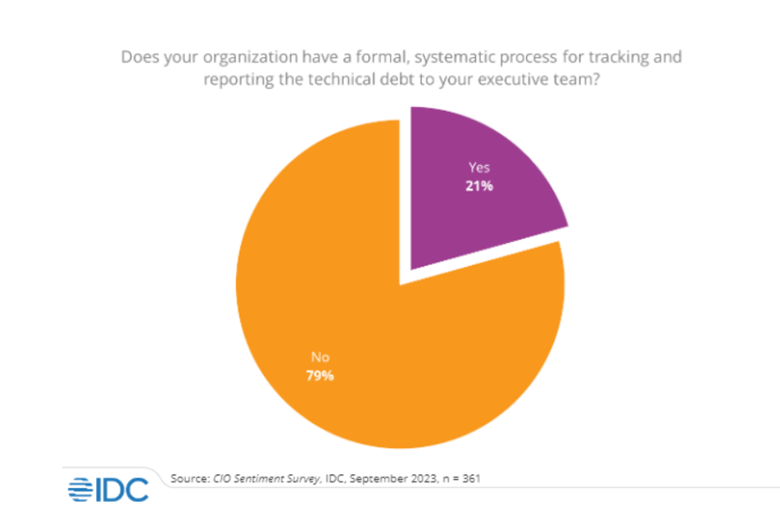“Key Highlights from the 2023 CIO Sentiment Survey” by Mona Liddell provides key insights to understanding the operational dynamics and strategic directions of IT organizations. In this blog, we’ll cover four that rise to the surface. Let’s dive in to some of them!
Firstly, let’s discuss Digital Transformation (DX). While integrated, continuous enterprise-wide DX strategies once took the spotlight, organizations are now leaning towards shorter-term approaches.
This shift may stem from factors like organizational learning curves, economic uncertainty, or the aftermath of global disruptions, such as the ongoing recovery from the pandemic. Figure 1 shows significant growth in organizations who have transformed or are integrated than over the previous year. Almost 65% were in the transformed or integrated maturity groups versus even a year previous where it was only 45% – an almost 45% increase.

Next on the agenda is Generative AI (GenAI), a topic sparking both excitement and caution. While about 32% of IT organizations have already adopted GenAI, a considerable number are still either not investing or only developing the use cases. This means these more conservative organizations are not developing the skills, building the data platforms, or examining the competitive advantages GenAI can provide.
IDC recommends piloting GenAI as a way to understand the potential business benefits, develop governance structures, and identify gaps within the organization to deliver its potential. Efforts can start with the simplest use cases, such as productivity, before expanding to functional and industry use cases.
GenAI isn’t a fad, like NFTs or the metaverse. It is a sea change on the level of the ’80s PC revolution and the ’00s smart phone transformation. A notable 22% of organizations are already adapting to the emergence of GenAI by actively changing their hiring plans. These companies may be creating new roles to leverage the early benefits of GenAI.
Meanwhile, cybersecurity remains a perennial concern, with varying investment priorities across organizations of different sizes. Both midmarket and large enterprises struggle to recruit cybersecurity talent, akin to finding a needle in a haystack. Larger enterprises due to more resources are less affected by this cybersecurity skill gap, but still struggle.
The question organizations need to consider is whether creative solutions can help bridge the gap, like using GenAI tools to summarize security alerts for less experienced staff, retraining existing staff, implementing robust internship programs, machine learning, and moving from discrete applications to a platform approach to security to simplify security management.

Technical debt poses another challenge, with a majority of organizations failing to allocate adequate resources or establish formal processes for its management.
While a majority of organizations allocate a small portion (12.8% average) of their IT budget to reduce technical debt, a significant number (79%) do not have formal processes for tracking and reporting this debt.
This gap in tracking and reporting could affect the strategic planning and alignment of IT initiatives with business objectives. It also reflects a need for more structured reporting and management practices to ensure that technical debt is accounted for in executive decision-making. However, amidst these challenges, there’s a silver lining: widespread adoption of cloud-based solutions and virtualization as integral parts of digital transformation endeavors.

These insights prompt several recommendations:
- Balance Short and Long-Term DX Strategies: Maintain equilibrium between short-term necessities and long-term digital roadmaps. Establish agile practices that allow for rapid adaptation between immediate market demands and long-term digital evolution to help ensure that short-term shifts don’t disrupt the broader business goals of the organization.
- Develop a Strategic Approach to GenAI Adoption: Plan strategically, incorporating governance principles and adoption roadmaps. In anticipation of GenAI-driven market changes, proactively revise IT hiring strategies while also upskilling current employees to ensure alignment with the future demands of GenAI integration.
- Invest in Cybersecurity Talent: Prioritize recruiting and developing cybersecurity professionals. Prioritize investments in training programs (e.g., certifications and workshops) to upskill current employees in cybersecurity practices and incorporate an internship program for fostering new talent, thereby mitigating the talent shortage by internally growing cybersecurity skills and introducing fresh perspectives through internships.
- Establish Formal Processes for Technical Debt Management: Implement structured processes for tracking and mitigating technical debt.. This should include regular audits of existing systems, quantification of debt, and documentation of remediation plans. Second, develop a prioritization framework to tackle technical debt, focusing on areas that yield the highest risk to the business or present opportunities for quick wins. A future tease is IDC will be releasing a methodology to assess technical debt in a report to be published in April 2024.
These insights, drawn from a global survey of IT leaders, provide valuable guidance. However, it’s essential to tailor strategies to fit individual organizational contexts and needs. The findings from this survey have been exclusively depicted in an eBook for technology leaders like you. Click the button below to download the eBook now.
Learn what matters most to your customers with IDC’s AI Use Case Discovery Tool—find out more.




